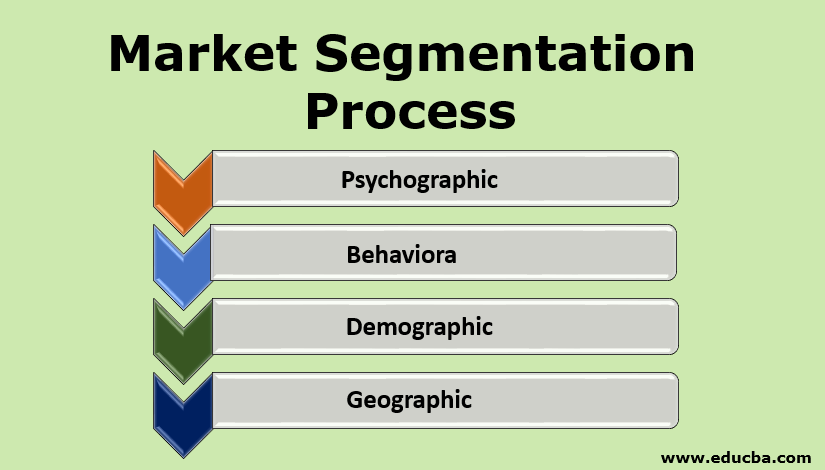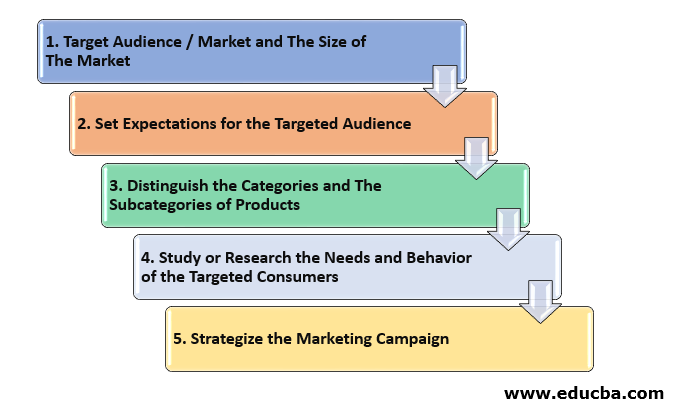
Introduction to Market Segmentation Process
Market Segmentation is the words that explain the segmentation or the segregation of a market based on different types, either type of customers or the type of products, and many other factors. Market Segmentation is very helpful during market research. Market Segmentation helps identify potential customers based on factors like homogeneity, distinctiveness, location or geography, trade or profession, social strata or status, etc. It allows the marketing team to plan their marketing strategies based on the type of customers and their choices and tastes. Also, these segments comprise customers based on their interests, needs, and location or commonalities among them. Market segmentation thus allows marketers to manage and plan their marketing campaigns in a customized or personalized way per the customer’s needs and demands.
Importance of Market Segmentation Process
The importance of the Market Segmentation Process is as follows:
- Market segmentation eases campaign management and helps to strategize marketing plans for marketers. Thus market segmentation allows marketers to customize their campaigns.
- Efficient market research and segmentation help save a lot of useful time, money, and resources invested in the marketing campaign. Also, the customers are grouped according to their needs, commonalities, choices, statuses, etc. It becomes easy to target the audience for the marketers. Thus, through market segmentation, the campaign management process is conducted smoothly, efficiently, and cost-effectively.
- Market segmentation helps to study the market needs and potential consumers, which reduces the risk of loss or unsuccessful marketing campaigns. As the market research is done before the campaign, the chances of success are much higher as the market segmentation helps the marketers do their homework for marketing. The marketers can strategize and plan their campaign per the potential consumers’ generic needs as per the market research. In a nutshell, market segmentation is highly effective in increasing the rate of success.
- Market segmentation can be used to prioritize the consumer or the target audience and how it benefits the marketers. Market segmentation helps you study the potential of the consumer to buy a particular product, which is the cornerstone factor for successful marketing and allows the marketers to offer discounts and deals to attract the consumers’ attention toward the product.
- By narrowing the market and the target, consumers help save money and other targeted resources engaged in marketing the product or specific campaign, which is crucial for any company, firm, or organization. For a better customer experience, understanding and prioritizing customer needs is essential.
Types
Types of Market Segmentation Processes are as follows:
1. Behavioral
Behavioral market segmentation refers to the segmentation of the market based on the behavior of the consumer interacting with the product, like what they love to shop, their occasion for shopping, travel plans, the budget of the consumer, etc. Behavioral segmentation is all about the consumer’s attitude towards the product and their buying process.
2. Demographic
Division or segmentation of the market based on demographic factors like age, gender, nationality, marital status, family size, profession, etc. Business Central Consultant helps narrow the market and consumers based on their interests and potential to spend or purchase products.
3. Geographic
As the name indicates, geographic segmentation refers to the bifurcation of the market based on the location or geography of the target audience or consumers. Other geographical segmentation factors may include climate, region, country, religion, language, and population.
4. Psychographic
Psychographic segmentation refers to the classification or the bifurcation of the market based on factors like consumers’ lifestyles, opinions, interests, views, attitude, social strata, personal habits, and their fellows and pals.
Market Segmentation Process
Step-To-Step Guidelines for Market Segmentation Process are as follows:
1. Target Audience / Market and The Size of The Market
Identifying the market and the target audience is the foundation for any marketing campaign. It helps marketers study the type of consumers in the target audience section and set expectations according to their needs. It helps organize and plan their marketing strategies as per the size of the target audience’s market and taste.
2. Set Expectations for the Targeted Audience
Once the target audience and size of the targeted audience are identified, it is necessary to review the needs and requirements of the consumers to meet the demands and expectations of the consumers.
3. Distinguish the Categories and The Subcategories of Products
Based on the demographic factors of the classification of the consumers, the marketers must subcategorize the products to fit the requirements of different age groups, different gender, and so on.
4. Study or Research the Needs and Behavior of the Targeted Consumers
The marketing team must review the needs and preferences of the consumers from each section of society. It will also be easy to develop a generic marketing strategy if the requirements of the consumers are studied and reviewed carefully.
5. Strategize the Marketing Campaign
Once the market research of all the necessary factors has been done, and the marketers have accumulated the consumer interest and their behavior, the marketing team is all set to strategize their campaign for a particular product or service. Different advertisements and promotions, banners, etc., are included to promote the product or the service. The promotion should be done to establish a connection between the consumer and the product or the service, as the connection is very important for the campaign’s success.
Market segmentation has been the cornerstone for all successful brands, whether the company/marketer was a product-based company or a service provider company. For example, Redmi/Xiaomi has established itself as the market’s most popular and highest-selling mobile phone brand as they did their homework correctly. They studied their consumers and their expectations and the consumers’ sensitivity towards the phones’ pricing. After reviewing the market carefully, they came up with a successful launch and promotion of the product.
Recommended Articles
This is a guide to the Market Segmentation Process. Here we discuss the introduction and Types of the Market Segmentation Process and Step-To-Step Guidelines for the Market Segmentation Process. You may also look at the following articles to learn more–

